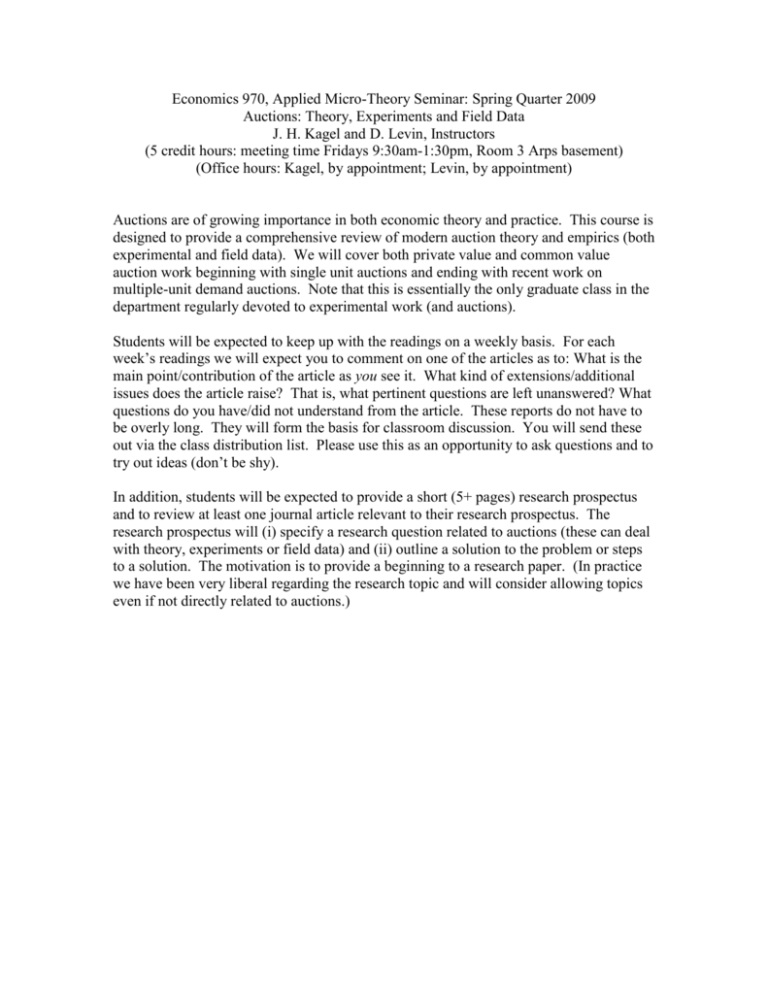Economics 970, Applied Micro-Theory Seminar: Winter Quarter 2005
advertisement

Economics 970, Applied Micro-Theory Seminar: Spring Quarter 2009 Auctions: Theory, Experiments and Field Data J. H. Kagel and D. Levin, Instructors (5 credit hours: meeting time Fridays 9:30am-1:30pm, Room 3 Arps basement) (Office hours: Kagel, by appointment; Levin, by appointment) Auctions are of growing importance in both economic theory and practice. This course is designed to provide a comprehensive review of modern auction theory and empirics (both experimental and field data). We will cover both private value and common value auction work beginning with single unit auctions and ending with recent work on multiple-unit demand auctions. Note that this is essentially the only graduate class in the department regularly devoted to experimental work (and auctions). Students will be expected to keep up with the readings on a weekly basis. For each week’s readings we will expect you to comment on one of the articles as to: What is the main point/contribution of the article as you see it. What kind of extensions/additional issues does the article raise? That is, what pertinent questions are left unanswered? What questions do you have/did not understand from the article. These reports do not have to be overly long. They will form the basis for classroom discussion. You will send these out via the class distribution list. Please use this as an opportunity to ask questions and to try out ideas (don’t be shy). In addition, students will be expected to provide a short (5+ pages) research prospectus and to review at least one journal article relevant to their research prospectus. The research prospectus will (i) specify a research question related to auctions (these can deal with theory, experiments or field data) and (ii) outline a solution to the problem or steps to a solution. The motivation is to provide a beginning to a research paper. (In practice we have been very liberal regarding the research topic and will consider allowing topics even if not directly related to auctions.) General References: Vijay Krishna, Auction Theory, Academic Press (2002). Milgrom, Paul, Putting Auction Theory to Work, Cambridge University Press (2004) Klemperer, Paul, Auctions: Theory and Practice, Princeton University Press (2004). (Most of this is available on line.) Surveys: Kagel, J. H. 1995. “Auctions: A Survey of Experimental Research,” in The Handbook of Experimental Economics, J. H. Kagel and A. E. Roth (eds). Princeton: Princeton University Press. Kagel, J. H. and Levin, D. , 2002. “Bidding in Common Value Auctions: A Survey of Experimental Research,” in Common-Value Auctions and the Winner’s Curse, Princeton Un. Press. McAfee, R.P., and J. McMillan. 1987. “Auctions and Bidding,” Journal of Economic Literature, 25:699-738. Wilson, R. 1992. “Strategic Analysis of Auctions,” in R.J. Aumann and S. Hart, Handbook of Game Theory with Economic Applications, Vol. 1. Amsterdam: Elsevier Science Publishers. Kagel, J. H. and Levin, D. (2008) “Auctions: A Survey of Experimental Research, 19952008” prepared for The Handbook of Experimental Economics, vol 2. J. H. Kagel and A. E. Roth (eds). Princeton: Princeton University Press (forthcoming). Other classic (general) references not cited above: Milgrom, P., and R.J. Weber. 1982. “A Theory of Auctions and Competitive Bidding,” Econometrica, 50:1485-527. Vickrey, William. 1961. “Counterspeculation, Auctions, and Competitive Sealed Tenders,” Journal of Finance, 16: 8-37. Topics/Tentative Schedule: Note, certain topics should be covered in any graduate auction class namely single unit private and common value auctions. We do this here and then move on from that to cover additional topics. The last class will be devoted to student presentations. We note by * primary readings. Other readings are optional/supplemental. Topics: I 4/10 Introduction/Private Value Auctions Meyerson, R. 1981, “Optimal auction design.” Mathematics of Operations Research, 6, 58-73. Riley, J. and Samuelson, W. F. 1981, “Optimal Auctions,” American Economic Review, 71:381-92. (Read one of these two as well as the following.) *Bulow, J. and Roberts, J. 1989. “The simple economics of optimal auctions.” Journal of Political Economy, 97, 1060-90. This class will begin in the economics lab. II 4/17 Behavior in Private Value Auctions Kagel, J. H. and Levin, D. 1993, “Independent private value auctions: Bidder behavior in first-, second-, and third-price auctions with varying numbers of bidders,” Economic Journal, 103: 868-79. *Kagel, J. H. 1995. “Auctions: A Survey of Experimental Research,” in The Handbook of Experimental Economics, J. H. Kagel and A. E. Roth (eds). Princeton: Princeton University Press. Part I sections A-C. Kagel and Levin (2008) ““Auctions: A Survey of Experimental Research, 19952008” section I III 4/24 Common Value Auctions *Wilson, R. 1977. “A Bidding Model of Perfect Competition,” Review of Economic Studies, 44: 511-18. Klemperer, P. 1998, “Auctions with almost common values: the ‘wallet game’ and its applications,” European Economic Review 42, 757–69. Levin, Dan and Kagel, John H., 2005, “Almost Common-Value auctions revisited,” European Economic Review, Vol. 49, No. xx, pp 1125-1136. This session will also start in the lab. IV 5/1 Behavior in Common Value Auctions *Kagel, J. H. and Levin, D. 2002 “Bidding in Common Value Auctions: A Survey of Experimental Research,” in Common-Value Auctions and the Winner’s Curse, Princeton Un. Press. (Introduction, parts A, B1-B4, C.1) *Kagel, J. H. and D. Levin. 1986. “The Winner's Curse and Public Information in Common Value Auctions,” American Economic Review, 76:894-920. Kagel and Levin (2008) ““Auctions: A Survey of Experimental Research, 19952008” section II. V 5/8 Endogenous Entry and When and Why not to Auction *Levin, D. and Smith, J. 1994. “Equilibrium auctions with entry.” American Economic Review, 84, 585-99. *______and_ _____, 2001. “Entry coordination in auctions and social welfare: An experimental investigation.” International Journal of Game Theory, 30, 32150. Campbell and Levin, 2006, “When and why not to auction,” Economic Theory, 27, 583-596. Kagel and Levin (2008) “Auctions: A Survey of Experimental Research, 19952008” section 4.4 VI 5/15 Multi-unit demand auctions *Dasgupta, Parta and Maskin Eric S., 2000, “Efficient Allocations,” Quarterly Journal of Economics, Vol. 115, No. 2, pp. 341-88. *Kagel and Levin (2001), “Behavior in multi-unit demand auctions: experiments with uniform price and dynamic Vickrey auctions,” Econometrica, pp 413-454. Kagel and Levin (in press) “Comparing Efficient Multi-Object Auction Institutions,” Games and Economic Behavior WP on Kagel’s website Cramton, Peter, 2004, “Simultaneous ascending auctions,” available on his web site. Cramton and Schwartz, 2002, “Collusive bidding in the FCC spectrum auctions” Contributions to economic analysis and policy (see Cramton’s web site for a copy to download). Kagel and Levin (2008) “Auctions: A Survey of Experimental Research, 19952008” section III VII 5/22 Package/Combinatorial/Synergies Theory: Efficiency vs. Abuse, Complexity; the Thresh-hold and the Exposure problems. Cantillon Estelle and Pesendorfer Martin, “Combination Bidding in Multi-Unit Auctions” Working paper LSE 2006. *Milgrom, Paul “Package Auctions and Package Exchanges,” Fishers-Schultz Lecture, European Econometric Society, 2004 (avail on his web site). *Brunner, C, Goree, J. K., Holt, C. A. and Ledyard, J. O. “An Experimental Test of Flexible Combinatorial Spectrum Auction Formats” (avail on Goree’s web site). Porter et al., 2003, “Combinatorial Auction Design,” Proceedings of the national Academy of Sciences, 100 (19) September, 11153-57. can be downloaded from www.pnas.org/cgi/doi/10.1073/pnas.1633736100 Chernomaz and Levin, 2007, “Efficiency and Synergy in a Multi-Unit Auction with and without Package Bidding: an Experimental Study.” (OSU working paper). Kagel, J. H., Lien, Y. and Milgrom, P. “Ascending Prices and Package Bidding: An Experimental Analysis” 2009, working paper. VIII 5/29 Auctions and IO Theory: Auctions with externalities. Auction where bidders care about other bidders and/or the market structure and competition after the auction. Auctions with Collusive bidding. Das Varma, Gopal, 2002, “Standard Auctions with Identity-Dependent Externalities,” RAND Journal of Economics, Vol. 33, No. 4, pp. 689-708. *Goree, Offerman and Sloof, “Demand reduction and preemptive bidding in multi-unit license auctions,” 2006. Should be available from web site of Jacob Goree (Cal Tech HSS) or Theo Offerman. *Moldovanu, Benny, Jehiel Philippe and Stacchetti Ennio, 1996, “How (not) to Sell Nuclear Weapons, American Economic Review, 86(4), 814-829. *Offerman, T. and Potters, J., 2006, “Does Auctioning of Entry Licenses Induce Collusion? An Experimental Study,” Review of Economic Studies, 73, 769-91. (available on Potters web site) IX 6/5 Class Presentations: Web sites for referenced authors – Econ 970, Spring 2009 Name John H. Kagel Affiliation Department of Economics Ohio State Paul Klemperer Economics Group Nuffield College Oxford University, UK Department of Economics Penn State Department of Economics Harvard Vijay Krishna Alvin E. Roth Journal Storage The Scholarly Journal Archive Web site www.econ.ohio-state.edu/kagel/ www.nuff.ox.ac.uk/economics/people/klemperer.htm http://econ.la.psu.edu/~vkrishna/index.html www.economics.harvard.edu/~aroth/alroth.html www.jstor.org







